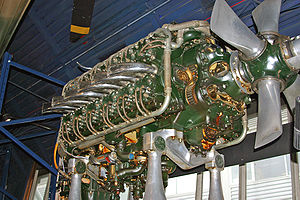Napier Sabre
| Sabre | |
|---|---|
 |
|
| Napier Sabre cutaway at the London Science Museum. | |
| Type | Liquid-cooled H-24 sleeve valve piston aero engine |
| National origin | United Kingdom |
| Manufacturer | D. Napier & Son |
| First run | January 1938 |
| Major applications |
Hawker Tempest Hawker Typhoon Napier-Heston Racer |
The Napier Sabre was a British H-24-cylinder, liquid-cooled, sleeve valve, piston aero engine, designed by Major Frank Halford and built by D. Napier & Son during World War II. The engine evolved to become one of the most powerful inline piston aircraft engines in the world, developing from 2,200 horsepower (1,640 kW) in its earlier versions to 3,500 hp (2,600 kW) in late-model prototypes.
The first operational aircraft to be powered by the Sabre were the Hawker Typhoon and Hawker Tempest; the first aircraft powered by the Sabre was the Napier-Heston Racer, which was designed to capture the world speed record. Other aircraft using the Sabre were early prototype and production variants of the Blackburn Firebrand, the Martin-Baker MB 3 prototype and a Hawker Fury prototype. The rapid introduction of jet engines after the war led to the quick demise of the Sabre, as there was less need for high power military piston aero engines and because Napier turned its attention to developing turboprop engines such as the Naiad and Eland.
Prior to the Sabre, Napier had been working on large aero engines for some time. Their most famous was the Lion, which had been a very successful engine between the World Wars and in modified form had powered several of the Supermarine Schneider Trophy competitors in 1923 and 1927, as well as several land speed record cars. By the late 1920s, the Lion was no longer competitive and work started on replacements.
...
Wikipedia
